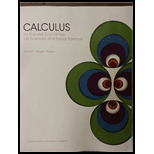
Problems 91–94 refer to the following: If a decrease in demand for one product results in an increase in demand for another product, the two products are said to be competitive, or substitute,
products. (Real whipping cream and imitation whipping cream are examples of competitive, or substitute, products.) If a decrease in demand for one product results in a decrease in demand for another product, the two products are said to be complementary products. (Fishing boats and outboard motors are examples of complementary products.) Partial derivatives can be used to test whether two products are competitive, complementary, or neither. We start with demand functions for two products such that the demand for either depends on the prices for both:
The variables x and y represent the number of units demanded of products A and B, respectively, at a price p for 1 unit of product A and a price q for I unit of product B. Normally, if the price of A increases while the price of B is held constant, then the demand for A will decrease; that is, fp(p, q) < 0. Then, if A and B are competitive products, the demand for B will increase; that is, gr(p, q) > 0. Similarly, if the price of B increases while the price of A is held constant, the demand for B will decrease; that is, gq(p, q) < 0. Then, if A and B are competitive products, the demand for A will increase; that is, fq(p, q) > 0. Reasoning similarly for complementary products, we arrive at the following test:
Test for Competitive and Complementary Products
| Partial Derivatives | Products A and B |
| fq(p, q) > and gp(p, q) > 0 | Competitive (substitute) |
| fq(p, q) < and gp(p, q) < 0 | Complementary |
| fq(p, q) ≥ and gp(p, q) ≤ 0 | Neither |
| fq(p, q) ≤ and gp(p, q) ≥ 0 | Neither |
Use this test in Problems 91-94 to determine whether the indicated products are competitive, complementary, or neither.
92. Product demand. The daily demand equations for the sale of brand A coffee and brand B coffee in a supermarket are
Want to see the full answer?
Check out a sample textbook solution
Chapter 7 Solutions
Calculus for Business, Economics, Life Sciences, and Social Sciences - Boston U.
- Solve by DrWz WI P L B dy Sind Ⓡ de max ⑦Ymax dx Solve by Dr ③Yat 0.75m from A w=6KN/M L=2 W2=9 kN/m P= 10 KN Solve By Drarrow_forwardA clothing manufacturer's profitability can be modeled by p (x)=-x4 + 40x² - 144, where .x is the number of items sold in thousands and p (x) is the company's profit in thousands of dollars. a. Sketch the function on your calculator and describe the end behavior. b. Determine the zeros of the function. c. Between what two values should the company sell in order to be profitable? d. Explain why only two of the zeros are considered in part c.arrow_forwardCCSS REASONING The number of subscribers using pagers in the United States can be modeled by f(x) = 0.015x4 -0.44x³ +3.46x² - 2.7x+9.68 where x is the number of years after 1990 and f(x) is the number of subscribers in millions. a. Graph the function. b. Describe the end behavior of the graph. c. What does the end behavior suggest about the number of pager subscribers? d. Will this trend continue indefinitely? Explain your reasoning.arrow_forward
- How to find the radius of convergence for the series in the image below? I'm stuck on how to isolate the x in the interval of convergence.arrow_forwarddjdjjdjdk4jr i need help on part C,arrow_forwardDetermine the exact signed area between the curve g(x): x-axis on the interval [0,1]. = tan2/5 secx dx andarrow_forward
- Question 2. An American option on a stock has payoff given by F = f(St) when it is exercised at time t. We know that the function f is convex. A person claims that because of convexity, it is optimal to exercise at expiration T. Do you agree with them?arrow_forwardQuestion 4. We consider a CRR model with So == 5 and up and down factors u = 1.03 and d = 0.96. We consider the interest rate r = 4% (over one period). Is this a suitable CRR model? (Explain your answer.)arrow_forwardQuestion 3. We want to price a put option with strike price K and expiration T. Two financial advisors estimate the parameters with two different statistical methods: they obtain the same return rate μ, the same volatility σ, but the first advisor has interest r₁ and the second advisor has interest rate r2 (r1>r2). They both use a CRR model with the same number of periods to price the option. Which advisor will get the larger price? (Explain your answer.)arrow_forward
 Linear Algebra: A Modern IntroductionAlgebraISBN:9781285463247Author:David PoolePublisher:Cengage Learning
Linear Algebra: A Modern IntroductionAlgebraISBN:9781285463247Author:David PoolePublisher:Cengage Learning

